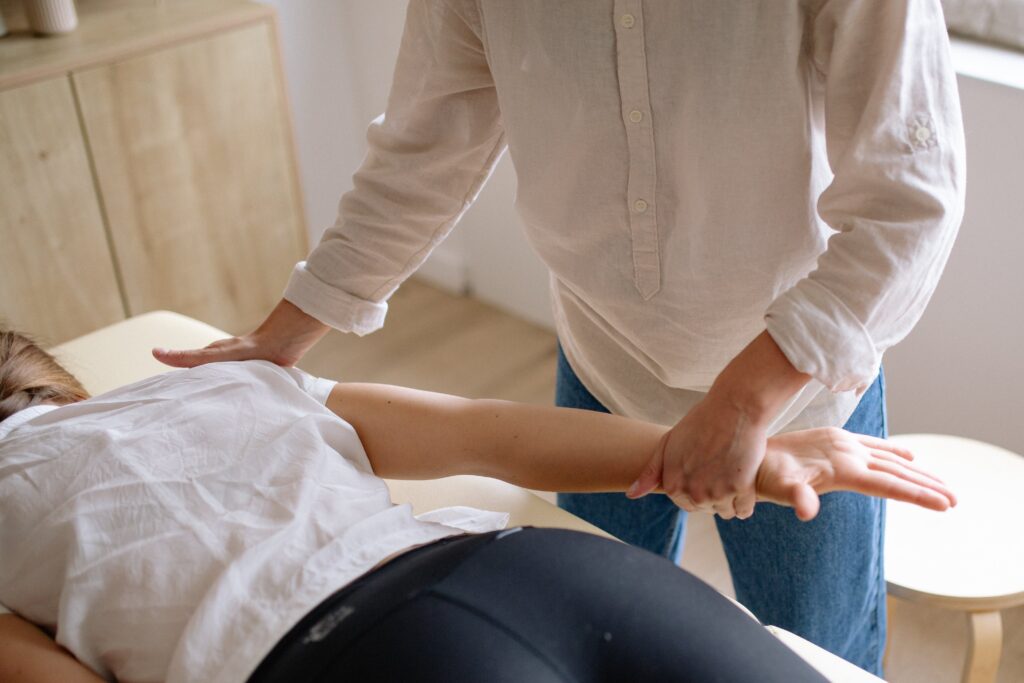Our Personalized Treatment Approach
At Zone 4 Physiotherapy & Wellness Centre, we believe in a thorough assessment that considers your entire body, focusing on the root cause of your pain or injury. Our treatment plans are personalized to help you recover and regain your strength, allowing you to resume activities you love.
Our diverse range of treatment modalities includes:
Manual Therapy
Experience hands-on treatments such as massage and joint mobilization, addressing specific areas of concern with precision and care.
Intramuscular Stimulation (IMS)
A specialized technique involving the use of acupuncture needles to release muscle tension and alleviate pain.
Exercise and Education
A holistic approach that combines targeted exercises with education about your injury, empowering you to prevent recurrence.
Advanced Technologies
We integrate cutting-edge technologies into our sessions, including Shockwave Therapy, Decompression Table, and Electrotherapy, to enhance the efficiency of your recovery process.
What We Treat
Lower Back And Pelvis
Back pain is a major global challenge. Almost anyone might have a great chance of suffering a disabling back injury regardless of occupation. The lumbar spine supports the upper body and transmits the weight of the upper body to the pelvis and lower limbs. Because of the strategic location of the lumbar spine, this structure should be included in any examination of the spine as a whole (i.e., posture) or in any examination of the hip or sacroiliac joints. Unless there is a definite history of trauma, it is often difficult to determine whether an injury originates in the lumbar spine, sacroiliac joints, or hip joints; therefore, all three should be examined in a sequential fashion.
Some of the common diagnoses lower back and pelvis conditions are:
Lumbar discopathy, Sacroiliac joint dysfunction, Osteoarthritis, spondylolisthesis, myofascial trigger points.
Why suffer from pain in the lower back and pelvis when physical therapy can take that pain away? BOOK AN APPOINTMENT to obtain that welcome relief!
Knee
The knee joint is particularly susceptible to traumatic injury because it is located at the ends of two long lever arms, the tibia and the femur. In addition, because the joint connects one long bone “sitting” on another long bone, it depends on the ligaments and muscles that surround it for its strength and stability, not on its bony configuration. Because the knee joint depends on its ligaments to such a great extent, it is imperative that the ligaments be tested during the examination of the knee.
Because of its anatomical arrangement, the knee is a complicated area to assess, and the examiner must take time to ensure that all relevant structures are tested. It must also be remembered that the lumbar spine, hip, and ankle may refer pain to the knee, and these joints must be assessed if it appears that joints other than the knee may be involved.
Some of the common diagnoses knee conditions are:
Osteoarthritis, ACL injury, Meniscus injury, Patellofemoral joint syndrome, Jumper’s knee.
Why suffer from pain in the knee when physical therapy can take that pain away? BOOK AN APPOINTMENT to obtain that welcome relief!
Foot And Ankle
At least 80% of the general population has foot problems, but these problems can often be corrected by proper assessment, treatment, and, above all, care of the feet. Lesions of the ankle and foot can alter the mechanics of gait and, as a result, cause stress on other lower limb joints, which in turn may lead to pathology in these joints. The foot and ankle combine flexibility with stability because of the many bones, their shapes, and their attachments.
Some of the common diagnoses foot and ankle conditions are:
Ankle sprain, Plantar fasciitis, Achilles tendinitis.
Why suffer from pain in the foot and ankle when physical therapy can take that pain away? BOOK AN APPOINTMENT to obtain that welcome relief!
Shoulder
The prerequisite to any treatment of a patient with pain in the shoulder region is a precise and comprehensive picture of the signs and symptoms as they present during the assessment and as they existed until that time. This knowledge ensures that the techniques used will suit the condition and that the degree of success will be estimated against this background. Shoulder pain can be caused by intrinsic disease of the shoulder joints or pathology in the structures around it, or it may originate from the cervical spine, chest, or visceral structures. Pathology is commonly related to the level of activity, and age can play a significant role. The shoulder complex is difficult to assess because of its many structures (most of which are located in a small area), its many movements, and the many lesions that can occur either inside or outside the joints. Influences such as referred pain from the cervical spine and the possibility of more than one lesion being present at one time, as well as the difficulty in deciding what weight to give to each response, make the examination even more difficult to understand. Assessment of the shoulder region often necessitates an evaluation of the cervical spine to rule out referred symptoms, and the examiner must be prepared to include the cervical spine and its scanning examination in any shoulder assessment.
Some of the common diagnoses Shoulder conditions are:
Adhesive Capsulitis (Frozen Shoulder), Arthritis, Dislocation, Bursitis, Rotator Cuff Tendonitis and Shoulder Impingement, SLAP tear
Why suffer from pain in the shoulder when physical therapy can take that pain away? BOOK AN APPOINTMENT to obtain that welcome relief!
Elbow
It is essential that the elbow and forearm functions optimally in order to enable participation in activities of work, sport, leisure and daily living. This region is more commonly afflicted by overuse or insidious injuries of the soft tissues than by fractures and dislocations. However, it is noteworthy to consider that the latter can be very debilitating and challenging to rehabilitate. One of the commonly diagnoses elbow conditions is Lateral Elbow Tendinopathy (Tennis Elbow). Tennis elbow is commonly called lateral epicondylitis, lateral epicondylalgia, or lateral epicondylosis depending on whether inflammation is present or not. Symptoms include pain in the outer aspect of the elbow with gripping activities. Activities requiring firm wrist stability, such as the backhand stroke in tennis, or repetitive work tasks that require repeated wrist extension, such as computer keyboarding or pulling weeds in garden, can stress the musculotendinous unit and cause symptoms.
Why suffer from pain in the elbow when physical therapy can take that pain away? BOOK AN APPOINTMENT to obtain that welcome relief!
Hand And Wrist
Injuries to the wrist and hand are common due to the constant involvement of the hand in most activities of daily living and sporting pursuits. Many of these injuries are a result of trauma, particularly in a physical occupation or sport, but there are a number of overuse conditions which can have a debilitating effect on the patient. There is a tendency to underestimate the importance of injuries to the wrist and hand but even the simplest injury, if not treated correctly, can have a disabling effect on not just sporting activities but activities of daily living.
Some of the common diagnoses hand and wrist conditions are:
Carpal tunnel syndrome (CTS), Dequervains synovitis, Arthritis
Why suffer from pain in the hand and wrist when physical therapy can take that pain away? BOOK AN APPOINTMENT to obtain that welcome relief!
How We Treat
Manual Therapy
It defines the hands-on techniques that therapists use to assist in the recovery of movement through joint mobility and muscle re-education. Some of the techniques that we use at zone 4 physiotherapy are: acupressure, joint mobilizations, muscle energy techniques, myofascial release. For more information, please contact us.
Dry Needling
Dry Needling in Physiotherapy :
Unraveling the Intricacies of Precision Healing
In the vast landscape of physiotherapy, innovative techniques continually emerge to offer patients new avenues for pain relief and enhanced mobility. One such technique gaining recognition is dry needling—a treatment approach that involves the strategic use of solid filament needles for therapeutic purposes. This post explores the nuances of dry needling, encompassing various methodologies like acupuncture, trigger point dry needling, intramuscular stimulation, and similar treatments employed by healthcare professionals to bring about transformative healing.
Understanding Dry Needling:
Dry needling is a comprehensive term encompassing a variety of treatment techniques where solid filament needles are inserted through the skin to stimulate specific points in the body. Unlike traditional acupuncture, which is rooted in traditional Chinese medicine, dry needling is based on Western medical principles and anatomy.
Key Modalities of Dry Needling:
Acupuncture:
- While acupuncture is often associated with traditional Chinese medicine, it is also considered a form of dry needling.
- Acupuncture involves the insertion of needles into specific points along energy meridians to restore balance and promote healing.
Trigger Point Dry Needling:
- This technique targets myofascial trigger points—tight bands of muscle fibers that can cause pain and discomfort.
- By inserting needles into these trigger points, physiotherapists aim to release tension and alleviate pain.
Intramuscular Stimulation (IMS):
- IMS focuses on stimulating dysfunctional nerves within muscles to promote healing and alleviate pain.
- Needles are strategically inserted into muscle tissue to release tension and improve overall muscle function.
How Dry Needling Complements Physiotherapy:
Pain Relief:
- Dry needling is often employed to provide immediate relief from musculoskeletal pain, addressing specific trigger points or areas of tension.
Improved Range of Motion:
- By targeting tight muscles and trigger points, dry needling can enhance flexibility and promote better range of motion.
Muscle Functionality:
- IMS, in particular, aims to restore optimal functionality to dysfunctional nerves and muscles, contributing to improved muscle performance.
Collaboration with Physiotherapy:
Dry needling is a specialized technique that is seamlessly integrated into the broader spectrum of physiotherapy. Physiotherapists, equipped with in-depth knowledge of anatomy and musculoskeletal function, skillfully apply dry needling to complement other therapeutic interventions and create a holistic treatment plan tailored to individual patient needs.
Conclusion: In the intricate tapestry of physiotherapy, dry needling emerges as a precise and targeted approach for pain relief and enhanced well-being. Whether through trigger point dry needling, acupuncture, or intramuscular stimulation, this technique reflects the evolving landscape of healthcare, offering patients a path to healing that aligns with Western medical principles.
As with any therapeutic approach, it’s crucial to consult with a qualified physiotherapist to determine the suitability of dry needling for your specific needs. In the hands of skilled professionals, dry needling becomes a key player in the symphony of healing, guiding individuals toward a pain-free and revitalized life.
For more information, please contact us.
Shockwave Therapy
Shockwave therapy is an evidence-based, non-invasive, and highly effective modality used in treating injuries such as:
- Plantar Fasciitis
- Achilles tendinopathy
- Jumper’s knee
- Hamstring tendinopathy
- Back pain
- Calcific rotator cuff tendinitis
- Trigger points
- Frozen shoulder and more.

Shockwave Therapy for Plantar fasciitis?
According to Hansen, Krogh, and Ellingsen (2018), shockwave therapy is the most effective treatment option for treating plantar fasciitis. Large randomized trials (RCT) supports the efficacy of shockwave therapy.
How frequently and how many sessions are required for shockwave therapy for plantar fasciitis?
A significant reduction in discomfort requires 3-5 shockwave treatments (Moya D, Ramo S, Schaden W et al., 2018). Sessions are typically once a week. The number of sessions required will vary depending on how quickly you react, how long the symptoms have been present, and how intense the pain is.
Our clinic provides high-quality treatments to customers and accepts ICBC & WorkSafeBC clients.
At ZONE 4 PHYSIOTHERAPY we use Swiss-made, shockwave technology.
Shockwave Canada Patient Educational Video
For more information, please contact us.
Electrotherapy
Electrotherapy and Pain Relief: The Power of Electrotherapy in Physiotherapy
In the realm of physiotherapy, one modality stands out as a powerful ally in the fight against pain and discomfort—Electrotherapy. This cutting-edge approach utilizes various techniques to alleviate the pain associated with a myriad of health conditions, ranging from shoulder pain to muscle weakness. In this post, we’ll explore the world of electrotherapy, shedding light on its mechanisms and how modalities like Interferential Current, Neuromuscular Electrical Stimulation, and Ultrasound are transforming the landscape of pain management.
Understanding Electrotherapy:
Electrotherapy involves the application of electrical stimulation to the body to promote healing, reduce pain, and improve muscle strength. It’s a versatile physiotherapy modality that finds its application in treating a wide array of health conditions. Whether you’re grappling with persistent shoulder pain, neck discomfort, low back pain, post-surgical pain, tendinitis, bursitis, muscle weakness, spasm, or inflammation, electrotherapy might be the solution you’ve been seeking.
Key Electrotherapy Modalities:
Interferential Current (IFC):
- IFC is a popular electrotherapy modality that utilizes the interference of medium-frequency electrical currents to stimulate nerves and muscles.
- By intersecting the currents, IFC provides deep tissue penetration, making it effective in managing pain associated with various conditions.
Neuromuscular Electrical Stimulation (NMES):
- NMES involves the application of electrical impulses to stimulate specific muscle groups.
- This modality is often employed to address muscle weakness, spasm, and to facilitate muscle re-education.
Ultrasound Therapy:
- Ultrasound, another prominent electrotherapy technique, utilizes high-frequency sound waves to promote tissue healing.
- It is particularly effective in reducing inflammation and alleviating pain associated with musculoskeletal conditions.
Benefits of Electrotherapy:
Pain Relief:
- Electrotherapy is renowned for its analgesic properties, providing effective pain relief for individuals dealing with chronic pain conditions.
Muscle Rehabilitation:
- NMES aids in muscle rehabilitation, making it a valuable tool in physiotherapy for those recovering from injuries or surgeries.
Improved Circulation:
- The stimulation provided by electrotherapy contributes to enhanced blood circulation, promoting better nutrient and oxygen delivery to affected areas.
Conclusion:
Electrotherapy is not just a buzzword; it’s a transformative approach in the realm of physiotherapy. By harnessing the power of modalities like Interferential Current, Neuromuscular Electrical Stimulation, and Ultrasound, healthcare professionals can provide targeted and effective relief for a spectrum of health conditions. If you’ve been grappling with pain or muscle-related issues, consider exploring the possibilities that electrotherapy may offer under the guidance of a qualified physiotherapist.
Remember, the journey to a pain-free life often begins with a single spark—let that spark be the power of electrotherapy.
Exercise Prescription
Exercise Prescription in Physiotherapy : Empowering Healing
Physiotherapy is a dynamic field that goes beyond traditional treatments to empower individuals on their journey to recovery. Among the arsenal of therapeutic approaches, exercise prescription stands out as a cornerstone for enhancing strength, flexibility, and overall well-being. In this blog post, we’ll delve into the symbiotic relationship between exercise prescription and physiotherapy, exploring how tailored exercise regimens can play a pivotal role in restoring mobility, preventing injuries, and promoting lasting health.
The Essence of Exercise Prescription:
At its core, exercise prescription in physiotherapy involves the systematic design and implementation of tailored exercise programs to address specific musculoskeletal issues, injuries, or chronic conditions. It’s a personalized roadmap to recovery that considers an individual’s unique needs, capabilities, and health goals.
Key Components of Exercise Prescription in Physiotherapy:
Assessment and Individualization:
- Physiotherapists conduct thorough assessments to understand the patient’s condition, taking into account factors like strength, flexibility, and any underlying health concerns.
- Based on the assessment, a customized exercise plan is crafted, ensuring that each exercise aligns with the individual’s abilities and goals.
Targeted Rehabilitation:
- Exercise prescription is particularly powerful in the rehabilitation phase after injuries or surgeries. Tailored exercises aid in the restoration of strength, flexibility, and functionality.
Prevention and Wellness:
- Physiotherapists utilize exercise prescription not only for rehabilitation but also for preventive measures. Strengthening exercises can help prevent future injuries and promote overall wellness.
Benefits of Exercise Prescription in Physiotherapy:
Muscle Strengthening and Endurance:
- Targeted exercises enhance muscle strength and endurance, promoting stability and reducing the risk of recurring injuries.
Improved Range of Motion:
- Specific exercises can improve joint flexibility and range of motion, crucial for individuals with musculoskeletal limitations.
Pain Management:
- Exercise prescription plays a pivotal role in managing pain, with carefully chosen exercises addressing the root causes of discomfort.
Enhanced Functional Capacity:
- Tailored exercises are designed to improve functional abilities, allowing individuals to perform daily activities with greater ease.
Collaboration between Patient and Physiotherapist:
Successful exercise prescription is a collaborative effort between the patient and the physiotherapist. Open communication, feedback, and the setting of realistic goals are essential elements in ensuring the effectiveness of the prescribed exercises.
Conclusion: Exercise prescription is not just a routine; it’s a personalized pathway to health and well-being. In the realm of physiotherapy, it serves as a guiding light, empowering individuals to take an active role in their recovery and preventive care. If you’re on a journey to better health, consider the transformative impact that exercise prescription, under the guidance of a skilled physiotherapist, can bring to your life.
Remember, each exercise is a step towards resilience, strength, and a healthier, more active future.
For more information, please contact us.
Telehealth Physio
Sometimes access to traditional in-person healthcare can be difficult for some under usual conditions and also throughout the COVID-19 pandemic. Telehealth, defined as the ‘delivery of healthcare at a distance using information and communication technologies like a video call or other video conference applications’ is a solution to many access barriers and has been rapidly adopted by many healthcare providers recently.
At ZONE 4 PHYSIOTHERAPY we offer telehealth physiotherapy. For more information, please contact us.








